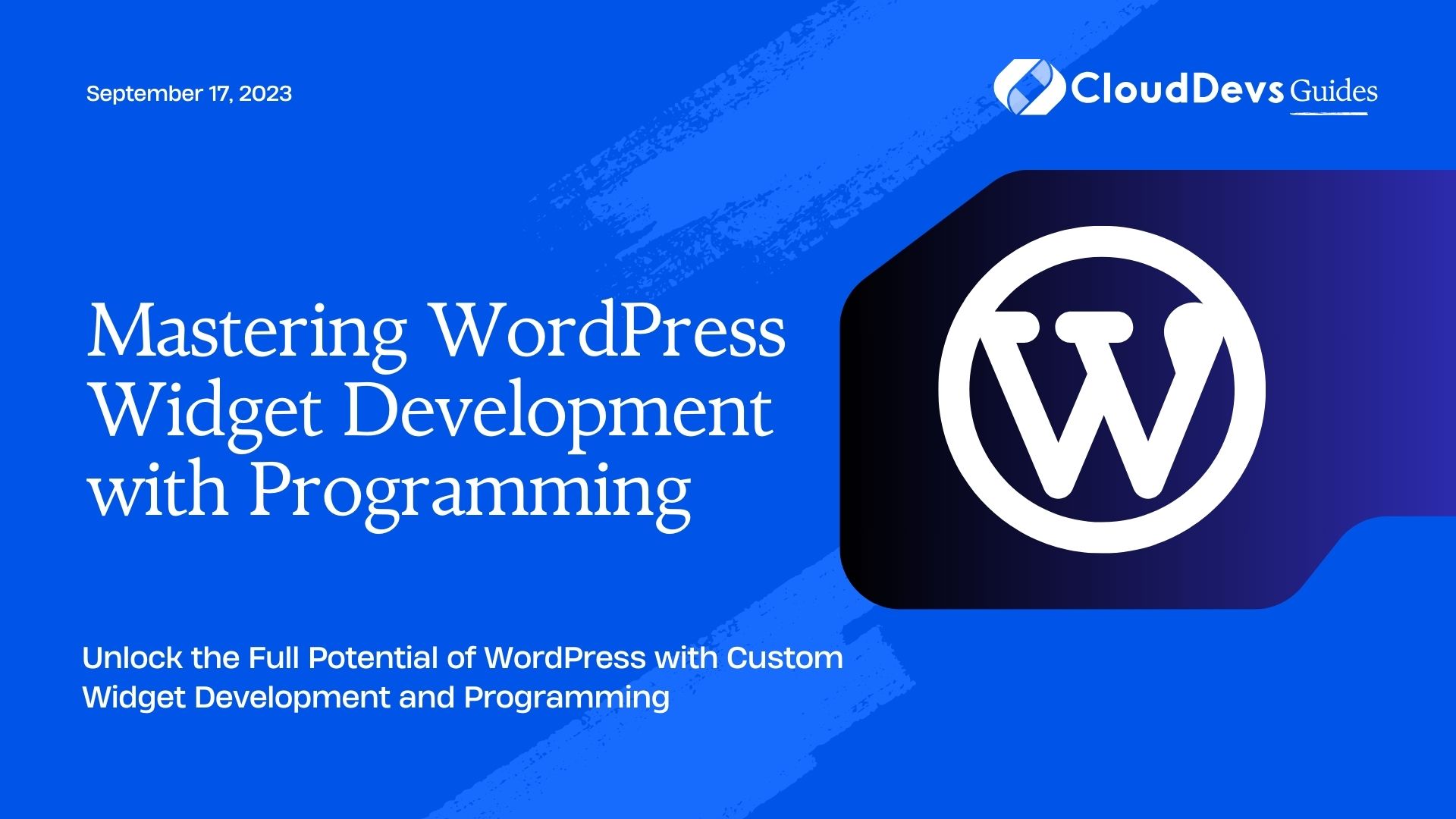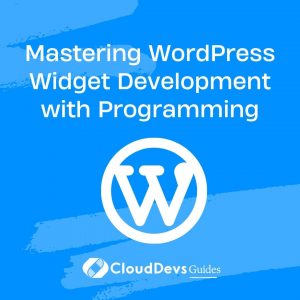Mastering WordPress Widget Development with Programming
WordPress, the world’s most popular content management system (CMS), empowers millions of websites. One of its key strengths lies in its extensive customization capabilities, allowing users to enhance functionality through themes and plugins. WordPress widgets are an integral part of this system, enabling developers to add various features and content to sidebars, footers, or any widgetized area of a WordPress website.
In this blog post, we will dive into WordPress widget development with programming, equipping you with the knowledge and skills to create custom widgets tailored to your specific needs. Whether you are an aspiring developer or a seasoned professional, this guide will walk you through the process of building robust and flexible WordPress widgets.
1. Understanding WordPress Widgets:
1.1 What Are Widgets?
WordPress widgets are small, self-contained modules that can be easily dragged and dropped into specific areas of a website’s theme, such as sidebars and footers. Widgets offer a simple way to add various functionality and content to your WordPress site without any coding knowledge. However, to create truly custom and powerful widgets, programming skills are essential.
1.2 Widget Areas in WordPress Themes
Most WordPress themes come with predefined widget areas. These areas, also known as sidebars, allow users to add widgets and customize the layout of their websites. Widget areas are defined in the theme’s files and can vary from theme to theme. Popular widget areas include the primary sidebar, secondary sidebar, footer columns, and more.
2. Getting Started with Widget Development:
2.1 Setting Up a Local WordPress Environment
Before diving into widget development, you’ll need a local WordPress environment for testing and debugging. To set up a local development environment, you can use tools like XAMPP or Local by Flywheel, which allow you to run WordPress on your computer.
2.2 Creating a Basic Plugin Structure
To build custom widgets, it’s best to create a WordPress plugin where you can encapsulate all your widget-related code. Start by creating a new folder in the wp-content/plugins directory of your local WordPress installation. Inside this folder, create a PHP file, e.g., my_widget_plugin.php, and add the plugin header information.
php <?php /* Plugin Name: My Widget Plugin Plugin URI: https://www.example.com/my-widget-plugin Description: A custom WordPress widget plugin. Version: 1.0 Author: Your Name Author URI: https://www.example.com */ // Plugin code goes here
2.3 Registering Your First Widget
In WordPress, widgets need to be registered with the system before they can be used. To register a widget, you’ll use the widgets_init action hook. In your plugin file, add the following code:
php
add_action('widgets_init', 'my_widget_init');
function my_widget_init() {
register_widget('My_Custom_Widget');
}
3. Building Your First WordPress Widget:
3.1 Widget Class and Inheritance
In object-oriented programming, widgets are represented as classes in WordPress. To create a custom widget, you’ll need to extend the base WP_Widget class.
php
class My_Custom_Widget extends WP_Widget {
// Widget code goes here
}
3.2 Implementing Widget Settings
Widgets often require user-configurable settings. To enable this, you’ll create form elements in the widget’s backend, allowing users to customize the widget’s behavior and content.
php
class My_Custom_Widget extends WP_Widget {
public function __construct() {
// Widget settings and options
$widget_options = array(
'classname' => 'my_custom_widget',
'description' => 'A custom widget for displaying... (add your description here)',
);
parent::__construct('my_custom_widget', 'My Custom Widget', $widget_options);
}
}
3.3 Adding Frontend Display
Now that your widget has settings, it’s time to display its content on the frontend. For this, you’ll override the widget() method in your widget class.
php
class My_Custom_Widget extends WP_Widget {
public function widget($args, $instance) {
// Widget frontend display code goes here
}
}
4. Advanced Widget Development Techniques:
4.1 Widget Hooks and Filters
WordPress offers numerous action hooks and filters that allow developers to modify the behavior of widgets or extend their functionality. For example, you can use the widget_title filter to modify the widget’s title before it is displayed.
php
add_filter('widget_title', 'my_custom_widget_title');
function my_custom_widget_title($title) {
// Modify the title here
return $title;
}
4.2 Custom CSS for Widgets
To provide users with an easy way to customize the widget’s appearance, you can add support for custom CSS classes to your widget.
php
class My_Custom_Widget extends WP_Widget {
public function widget($args, $instance) {
$widget_classes = isset($instance['widget_class']) ? $instance['widget_class'] : '';
echo '<div class="' . esc_attr($widget_classes) . '">';
// Widget content goes here
echo '</div>';
}
public function form($instance) {
$widget_classes = isset($instance['widget_class']) ? $instance['widget_class'] : '';
?>
<p>
<label for="<?php echo $this->get_field_id('widget_class'); ?>">Widget Custom Class:</label>
<input class="widefat" id="<?php echo $this->get_field_id('widget_class'); ?>" name="<?php echo $this->get_field_name('widget_class'); ?>" type="text" value="<?php echo esc_attr($widget_classes); ?>" />
</p>
<?php
}
}
4.3 AJAX-powered Widgets
To create widgets that load content dynamically without refreshing the page, you can use AJAX techniques. This is especially useful for widgets that display real-time data, such as social media feeds or notifications.
php
// AJAX handler for fetching widget content
add_action('wp_ajax_my_custom_widget_ajax', 'my_custom_widget_ajax_callback');
add_action('wp_ajax_nopriv_my_custom_widget_ajax', 'my_custom_widget_ajax_callback');
function my_custom_widget_ajax_callback() {
// Your AJAX logic goes here
// Return the widget content as JSON
wp_send_json($response);
}
5. Leveraging APIs for Enhanced Widgets:
5.1 Utilizing WordPress REST API
The WordPress REST API allows you to interact with your WordPress site programmatically, enabling you to fetch data and display it within your widgets.
php
// Example of fetching and displaying posts using the WordPress REST API
class My_Custom_Widget extends WP_Widget {
public function widget($args, $instance) {
// Fetch posts using the REST API
$api_url = 'https://example.com/wp-json/wp/v2/posts';
$response = wp_remote_get($api_url);
if (is_array($response) && !is_wp_error($response)) {
$posts = json_decode($response['body']);
if (!empty($posts)) {
echo '<ul>';
foreach ($posts as $post) {
echo '<li><a href="' . esc_url(get_permalink($post->id)) . '">' . esc_html($post->title->rendered) . '</a></li>';
}
echo '</ul>';
}
}
}
}
5.2 Fetching External Data with APIs
You can also utilize external APIs to enrich your widgets with data from other platforms or services.
php
// Example of fetching and displaying weather data from an external API
class My_Custom_Widget extends WP_Widget {
public function widget($args, $instance) {
// Fetch weather data from an external API
$api_url = 'https://api.example.com/weather?location=city_name';
$response = wp_remote_get($api_url);
if (is_array($response) && !is_wp_error($response)) {
$weather_data = json_decode($response['body']);
if (!empty($weather_data)) {
echo '<p>Current temperature: ' . esc_html($weather_data->temperature) . '°C</p>';
echo '<p>Weather conditions: ' . esc_html($weather_data->description) . '</p>';
}
}
}
}
5.3 Integrating Social Media Feeds
Social media feeds are a popular addition to websites. You can integrate feeds from platforms like Twitter, Instagram, or Facebook into your widgets.
php
// Example of displaying a Twitter feed in a custom widget
class My_Custom_Widget extends WP_Widget {
public function widget($args, $instance) {
// Fetch Twitter feed using an appropriate library or API
$twitter_feed = my_custom_fetch_twitter_feed();
if (!empty($twitter_feed)) {
echo '<ul>';
foreach ($twitter_feed as $tweet) {
echo '<li>' . esc_html($tweet['text']) . '</li>';
}
echo '</ul>';
}
}
}
6. Best Practices for Widget Development:
6.1 Writing Secure Code
Security is paramount when developing plugins or widgets. Ensure that your code follows WordPress coding standards, and properly sanitize user input to prevent vulnerabilities like SQL injection or cross-site scripting (XSS) attacks.
php
// Example of sanitizing user input in a widget
class My_Custom_Widget extends WP_Widget {
public function widget($args, $instance) {
// Sanitize the user input before usage
$title = isset($instance['title']) ? sanitize_text_field($instance['title']) : '';
echo $args['before_widget'];
echo $args['before_title'] . apply_filters('widget_title', $title) . $args['after_title'];
// Widget content goes here
echo $args['after_widget'];
}
}
6.2 Performance Optimization Tips
Optimize your widgets for performance to avoid negatively impacting the website’s loading speed. Minimize external API calls, implement caching, and avoid resource-heavy operations within the widget.
php
// Example of implementing caching in a custom widget
class My_Custom_Widget extends WP_Widget {
public function widget($args, $instance) {
// Check if the widget content is already cached
$cached_content = get_transient('my_custom_widget_cache');
if (false === $cached_content) {
// If not cached, fetch the widget content and store it in the cache
$widget_content = '...'; // Your widget content generation code
set_transient('my_custom_widget_cache', $widget_content, DAY_IN_SECONDS);
echo $widget_content;
} else {
// If cached, display the cached content
echo $cached_content;
}
}
}
6.3 Compatibility with Different Themes
Test your custom widgets with different WordPress themes to ensure they work seamlessly across various design styles and layouts. Account for potential theme-specific CSS and JavaScript conflicts and make your widgets as flexible as possible.
Conclusion
Congratulations! You have completed the journey to mastering WordPress widget development with programming. By learning how to create custom widgets and utilizing advanced techniques like API integration, you can now enhance your WordPress websites with powerful, tailor-made functionality. Remember to follow best practices and consider the user experience when developing your widgets.
Whether you’re building widgets for your own projects or creating premium plugins for others, your newfound expertise will undoubtedly set you apart as a skilled WordPress developer. Embrace continuous learning and stay up-to-date with the latest WordPress developments to remain at the forefront of web development and provide the best possible solutions for your clients and users. Happy coding!
Table of Contents








